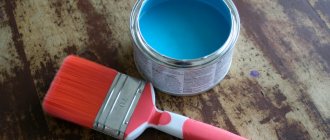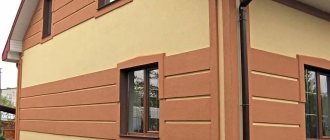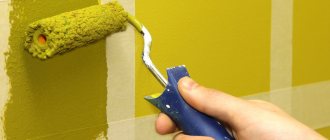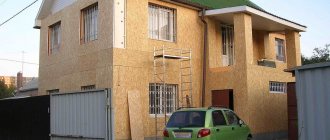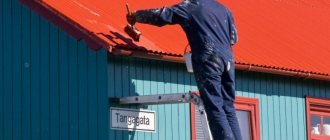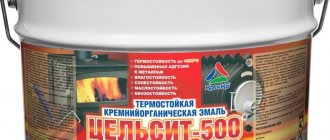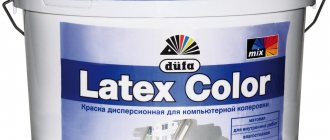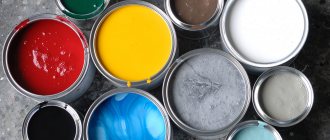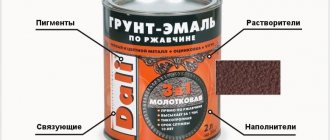If you decide to paint your house, then first you need to decide how much paint or cans of paint you will need so that the work is carried out thoroughly, in two or even three layers - a lot depends on the type of material and the surface being treated.
In this article we will learn not only how to correctly determine the consumption of facade paint per 1 m2, but also how to apply it.
Types of facade paint
Façade coverings are not just for design purposes – their main function is to protect the building structure. A reliable façade system is only possible if the coating is optimally matched to the corresponding substrate. When choosing a façade paint composition, take into account the influence of environmental conditions and color combinations.
Acrylic compounds
Acrylic facade paint is popular among craftsmen and decorators. It is water soluble, but if it gets on clothing and dries, it will be almost impossible to remove. Dried acrylic creates a waterproof film, so this binder is suitable for facades. Acrylic compounds can be used on surfaces such as wood, metal, concrete, brick, fabric and ceramics. Acrylic composition can even be applied to plastic, but it is not designed specifically for this material. Water-based paint coatings do not always adhere well to a plastic base. It works best on surfaces that allow air to pass through, such as wood and paper. Any acrylic compositions can be mixed with each other to obtain the desired shades of color. Acrylic paint can be applied over or under any other similar layer, still wet or already dry. Acrylic adheres well to itself, so each new layer can be applied without fear or special preparation. The high consumption rates of such formulations are explained by their low price. Acrylic compounds form a flexible coating, are resistant to rainwater and are available in a variety of colors, incl. intensive. They have average resistance to stains, but can be easily washed, including under pressure. Washing hard-to-reach, high walls is not easy, so in places where the air is heavily polluted, it is better to choose a different composition. Flaws:
- Algae grows on acrylic coatings, forming characteristic green spots. This especially applies to areas that are constantly shaded. For example, when the house is located among trees or on northern walls. Additives such as Teflon can significantly reduce this phenomenon.
- Mold also grows on acrylic coatings, forming a black coating.
- The biggest disadvantage of acrylic compositions is their relatively low vapor permeability. Therefore, they are not suitable for vapor-permeable (hygroscopic) substrates, incl. gas silicate walls covered with cement plasters.
Pay attention to: How to paint a guitar
Silicone paints
Silicone facade paint based on silicone resin is a water-repellent and air-permeable coating designed for all types of load-bearing surfaces. Thanks to the silicone system, water-repellent properties and very good permeability to water vapor, silicone coatings ensure constant dryness of facades. Many silicate compounds are self-cleaning. Characteristics of silicone facade coatings:
- matte;
- water-repellent;
- with high weather resistance;
- with high permeability to water vapor;
- with low tendency to accumulate dirt;
- can serve as a protective film against algae and fungal contamination of the coating;
- very economical to use;
- do not foam;
- provide good protection against aggressive air pollutants;
- quick-drying;
- microporous;
- without film-forming substances;
- very easy to apply;
- have good hiding power;
- durable;
- do not fade, because UV resistant.
Cement paints
Cement paints are used mainly in the restoration of old buildings. They are characterized by excellent adhesion to cement and cement-lime substrates and are uniquely durable. Such compositions are sold in dry form and before use are diluted with water to the desired consistency. They are applied in 2 layers, which form a relatively thick coating, characterized by high water absorption and vapor permeability. Cement compositions show the highest consumption: 0.5-0.7 kg per 1 square meter for 2 layers. They are rarely used when finishing the facades of residential buildings, because... Rough cement compositions are easily contaminated and their color palette is limited. Although, in terms of cost, cement-based paint compositions are the cheapest.
Polysilicate and silicate paints
Silicate coatings (based on potassium liquid glass) are more expensive than acrylic coatings and are available in fewer colors. On the other hand, they are resistant to pollution and algae growth. The best durability among all paints available on the market is due to the fact that they form a highly alkaline substrate (pH 11-12). Therefore, neither algae nor fungi grow on silicate coatings, incl. mold. In a forested, humid area this would be a good choice. The silicate composition has good vapor permeability, but is less resistant to water - after rain there may be wet spots on the facade. Luckily they dry out easily. When painting with silicate compounds, special attention should be paid to weather conditions - during the first few days the coating is not resistant to rain, strong sunlight and wind. Silicate paints are ideal for brick, concrete and other hygroscopic substrates, such as gas silicate walls, because... they are vapor permeable. In addition to high vapor permeability, there is high resistance to adverse weather conditions, mechanical damage and cleaning. For 20 years (or more), silicate coatings remain on facades like new. Polysilicate paints are made on the basis of silicate paints, adding various resins to them. This makes the composition more flexible and easier to work with. Due to such additives, the composition becomes less alkaline, and therefore less resistant to the growth of fungi and algae.
Acrylic paint
Silicone paint
Silicate paint Pay attention to: Painting ceramic tiles in the bathroom, kitchen, floor: choosing the necessary paint, step-by-step work technology
Which one to choose for painting a brick facade?
External walls are often finished with facing bricks. This type of brick does not require additional coating . But there are cases when it is necessary to paint sand-lime brickwork.
For example, you want to update an old wall or emphasize a masonry element. Sand-lime brick consists of quartz sand and lime, so you need to choose a coloring composition with high resistance to alkali . The properties are similar to ceramic, i.e. clay, but less water resistant. Therefore, when choosing a paint composition, the main attention should be paid to moisture resistance.
Most often, acrylic paints are used for these purposes, which, in addition to high moisture resistance, have good vapor permeability, wear resistance and an affordable price. Sand-lime brick has a light surface, so it is possible to use almost any color in painting . Just remember that when repairing a painted surface, it is often impossible to change the color of the coating, because the darker color will show through the lighter paint.
Consumption rate for façade paint per 1 m2 of plaster
What will be the consumption of facade paint per 1 m2 of plaster depends on many factors. First of all, it depends on the absorbency of the base and the consistency of the paint composition. The consumption rates indicated by the manufacturer on containers with the composition are lower than the actual consumption. After all, in production laboratories, tests are carried out on ideal surfaces. Standard consumption of facade paint per 1 m2 per 1 layer with 1- and 2-layer coating, kg:
- acrylic 0.25 – 0.15;
- silicone 0.3 – 0.15;
- silicate 0.4 – 0.35.
Roughly speaking, the consumption rate per 1 m2 of facade paint indicated by the manufacturer is indicated for coating a smooth metal surface that practically does not absorb the composition. But facades are usually plastered or made of wood, and have varying degrees of absorbency. Different plasters vary greatly in their ability to absorb liquids. Cement plaster is much more absorbent than silicone plaster. The roughness of the surface also matters - the more textured the surface, the more paint it will require. “Bark beetle” or “Lamb” plasters with a paint composition will cost 30-35 percent more than the standard consumption indicated on the bucket of paint. An old wooden facade will require 2 times more coating than a metal surface.
Instructions for painting the facade
Choosing façade paint color
The work must be carried out in good weather conditions specified by the manufacturer (on a sunny day, at an appropriate temperature, preferably in the range of 20-25°C, when there is no wind). Under these conditions, primers and paints form the most reliable protective dry film.
Step 1. Surface preparation
Preparing for painting old house walls
Before applying paint, the surface is prepared. It is important to make sure that the wall surface is clean and free of dirt, peeling paint and cracks.
High-quality plastered facade
Preparing to paint the facade of a new house
Step 2: Primer
It is necessary to use a special primer that matches the selected type of paint. The primer improves adhesion and absorption, preventing staining caused by uneven paint absorption. Walls coated with primer are easier to paint; such preliminary preparation of surfaces will significantly reduce material consumption.
Spraying primer
Step 3. Painting
DIY wall painting
If the primed wall is shiny, this means that it must first be painted with diluted paint in a 1:1 ratio and only then applied in the concentration recommended by the manufacturer. The thicker the paint layer, the better the protection of the facade. Therefore, do not dilute all the finished paint - it is formulated to provide the longest lasting protection. And, of course, you need to be careful when choosing colors. Some shades, such as deep blues and reds, will fade faster.
Facade plastered and painted in warm colors
Bright facade paints for plaster
A successful combination of two shades of green
Bright yellow facade of a house
Video - Painting plastered facades
Before you paint the facade of your house, you should calculate the consumption of facade paint. You need to calculate the amount that will allow you to carefully carry out all the work and paint the surface in several layers.
When calculating, it is important to take into account the characteristics of the surface and the type of paint and varnish material. There are many nuances here that can affect the consumption of materials for painting exterior objects.
Before painting the facade of a building, it is necessary to calculate the paint consumption for the entire area. Calculation depending on the type of material.
The most important parameter that must be taken into account when calculating the required paint composition for facade work is the type of paint . The paint and varnish material is selected depending on the characteristics of your facade. In this case, the consumption for each type will be individual.
Water-based paint
The basis for water-based paint is water, which contains an insoluble emulsion in the form of pigment. After applying such a composition to any surface, the water evaporates and only the pigment base remains in the form of a colored layer.
If you decide to purchase a composition of this type, then you should know that for facade work it is applied in two layers. The time interval between painting two layers should be more than one and a half hours.
Advantages:
- resistance to frost;
- low water permeability;
- lack of response to exposure to ultraviolet rays;
- acceptable cost.
The calculation in this case should be based on the fact that about 300 grams of the composition are usually consumed per 1 m2 of the surface of the facade walls. That is, if you need to paint 10 m2 of facade, you will need to purchase at least 3 liters of paint and varnish material.
Acrylic paintFacade acrylic paint retains color well over time
Acrylic-based paints and varnishes are an ideal option for facade work. Advantages of acrylic painting:
- duration of preservation of the bright color and protective properties of the coating;
- resistance to aggressive atmospheric factors such as high humidity, wind or direct sunlight;
- ease of maintenance, for which ordinary detergents are sufficient;
- fire safety;
- absolute safety for human health;
- versatility that allows you to process any façade surface, from brick or concrete to solid wood.
As a rule, the consumption of acrylic paint is less than water-based paint. Typically it ranges from 150 to 200 grams per 1 m2. A more accurate consumption of façade paint per 1 m2 depends on how bright you want the painted coating to be. You can finally decide only by directly applying the composition to the surface.
If you get the required shade in one or two layers, then per 1 m2 you will need approximately 130-170 grams. If you need to obtain a more saturated color, you will have to count on 200 grams per 1 m2.
Oil paints and varnishesConsumption of oil paint depends on the desired brightness of the color
The oil composition consists of drying oil, color pigments and various fillers. At the same time, fillers can be sold both as part of the paint and in the form of separate solutions. If you are dealing with thickly grated oil compositions, you will have to dilute them a little before applying.
Calculating the consumption of oil paint, like acrylic paint, also depends on the desired brightness of the color. For example, if you apply a small amount of red composition to the surface of façade walls, it will look pink. The standard consumption for painting on plaster is usually 150 grams per 1 m2 and can vary depending on the required color.
Alkyd paint
Alkyd paint and varnish material is based on alkyd resins, which are used in production. Its peculiarity is that for facade work the composition must be diluted with turpentine, kerosene or drying oil. When diluted, each of these components will have an individual consumption of material per 1 m2 of surface to be painted. Therefore, in order to more accurately calculate consumption, you should take into account the number of additional mixtures that are used to obtain a brighter shade.
Traditionally, the consumption of façade paint per 1 m2 of wall surface is small and amounts to about 100 grams. That is, for 10 m2 you will need to spend only a liter of paint. A distinctive feature of the alkyd composition is the creation of a stylish and original appearance. In addition, such paint will protect the facade surface from the appearance of fungi and mold.
Thus, now you know the approximate consumption for each type of paint. At the same time, when choosing a composition for facade work, you need to take into account a number of nuances related to its consumption. This way you will save time and will not have to buy the missing paint. In this case, you will not be left with an excess amount of paint and varnish composition.
The quality of the exterior decoration of a house is assessed primarily by what kind of paint the walls are painted - color, level of gloss, density and other surface qualities that are visible with your own eyes and make it possible to get a general impression of the level of work performed.
Thus, facade paint is a kind of calling card of the house, creates its overall appearance and emphasizes the individuality of the owner.
Meanwhile, the role of the outer covering is much more complex and important than the usual decoration of the outer surface of the walls.
Facade paint provides complete protection of the building material from the effects of atmospheric moisture, compensates for minor movements during shrinkage or seasonal fluctuations of the soil, and ensures the removal of steam from the wall pie. All these functions are not visually noticeable, but for the longevity of the house they are much more important than decorative qualities.
We independently calculate paint consumption
In rare cases, facade painting is limited to 1 layer. Usually 2 layers are applied, professionals include this indicator in the estimates. But depending on the absorbency of the base and the thickness of the composition, three or more layers may be required. In any case, when purchasing material, you must immediately multiply the consumption indicated on the label by 20% (or a factor of 1.2). This is the average amount of absorption by the base. But it can be much higher. The higher the water absorption of the material, the greater the magnification factor. To correctly calculate paint consumption, it is best to do this experimentally. Buy a small test batch and paint on some small secluded area of the wall. This way you will know exactly what the covering power of the composition is and how many layers will be required for a particular façade. Next, the standard paint consumption per 1 square meter of base, multiplied by the absorption coefficient (20%), is multiplied by the area of the facade and multiplied by the number of layers.
Calculating paint consumption
What determines the consumption of paints and varnishes and how to calculate it
Facade plaster consumption per m2 is always indicated by the manufacturer on the packaging. But this indicator is considered average and can only be taken into account when creating optimal working conditions, which is not always feasible in practice. Consumption may be affected by:
- The quality of the base, uneven and unprepared walls will require the application of a thicker layer of product to obtain a beautiful result;
- The presence of pores in the material also increases consumption;
- The number of layers of paint that will be applied to obtain the desired bright and even result;
- Tools that will be used to distribute the layer. The most expensive brush option, the most economical spray bottle.
If operating conditions are optimal, you can use an online calculator where you need to enter the surface area and average flow rate.
The most expensive brush option, the most economical spray bottle.
What affects paint consumption?
We have already become familiar with the influence of the base on the consumption of decorative coatings. Now let’s look at what characteristics of the composition itself affect its consumption. This will allow you to avoid the tricks of manufacturers interested in high consumption of their goods.
- Water absorption coefficient. Its average value is 0.05 kg/sq.m. The higher this indicator, the higher the consumption of the paint composition. The lower, the more resistant the coating is to water.
- Type of binder. The maximum consumption is for the cement composition. The consumption of façade acrylic paint is minimal.
- Amount of binder. There is a direct relationship here - the more binder in the composition, the thicker the composition, and the greater its consumption.
- Presence of polymer fibers. They are added to thicken facade paints. Thanks to them, small cracks, up to 0.5 mm, are well masked. The higher their content, the thicker the composition and the greater its consumption.
Uneven surfaces also increase paint consumption.
Types of concrete paints for exterior use
Construction stores offer a large selection of painting compounds. The following types are distinguished based on the presence of the main component:
- Acrylic.
- Water-based epoxy is a mixture of primer and dye with additional components.
- Polymer - synthetic polymers are used.
- Vinyl.
- Acrylic-silicone.
- Oily.
- Water-based.
- Calcareous.
According to the method of preparation, there are the following types:
- Water-soluble - diluted with water, do not have an unpleasant odor, and are environmentally friendly.
- Based on organic solvents - highly flammable and do not allow steam to pass through. It is not recommended to buy for interior work.
By appearance after drying, smooth and textured surfaces are distinguished, as well as glossy and matte.
Acrylic paint
This concrete paint for exterior use repels moisture and has excellent wear resistance. Manufacturers do not add harmful impurities to the composition, therefore it is a safe option for both humans and nature.
Easy to apply to concrete surfaces. Dries quickly and can be used for about 10 years. There are also several disadvantages:
- Poor frost resistance.
- High cost of material.
Water-based epoxy paint
This paint consists of two components - a primer and a dye. Be sure to mix thoroughly before use. Also, the mixed components are left for 15 minutes, after which they begin to work.
This option is universal; it can be used indoors and outdoors. The paint repels moisture, is wear-resistant and flexible. The disadvantages include the rapid loss of brightness of the coloring component. Therefore, it is better to paint buildings that are in the shade with such compositions.
Silicate
Concrete can be painted with silicate paint. Liquid glass is used as a basis, to which dyes and other fillers are added to improve the characteristics of the material. The coloring composition protects the base from external influences.
Disadvantages include the laboriousness of removal from the facade, changing the shade if necessary, as well as toxicity and difficulty in application.
Polymer paint
This frost-resistant composition appeared on the building materials market quite recently. Despite the high cost and long drying period, the material is very popular. All thanks to good abrasion and chemical resistance.
Water-based
The main component is water, where dyes and additional components dissolve, which allow the solution to be easily applied to the surface. In addition, the layer dries quickly, does not produce unpleasant odors, and does not have toxic fumes. Therefore, such coloring compositions are suitable for use not only for exterior, but also for interior work.
Oily
You can buy oil-based facade paint for exterior concrete work. This option is the most affordable. The new layer protects the main structure well from moisture, but a large number of shortcomings make this finish less practical than others.
Vinyl paint
The coloring composition always has a rich color, so it covers the gray base well. In some cases, one layer is enough, but professionals still recommend doing 2. The service life of such paint is long, since it is wear-resistant. Before application, the components are thoroughly mixed.
Acrylic silicone paint
This option incorporates the positive properties of both acrylic and silicone filler. After drying, the layer becomes plastic and easily adapts to high and low temperatures. It has good wear resistance and external mechanical influences. Such paints are called rubber paints.
Lime paint
This option is sold either in finished form or as a semi-finished product that needs to be diluted with water before use. The composition has bactericidal properties, so fungi, mold and insects do not settle on such a facade. This is a super-frost-resistant façade paint for exterior concrete work, as it allows steam to pass through from interior spaces.
But there are several serious disadvantages here:
- Contaminants are absorbed into the surface and cannot be washed off.
- Short service life - no more than a year, if you do not use tricks during application.
- Professionals add table salt or drying oil to the solution.
- Poorly protect the façade from precipitation.
- Small selection of shades.
How to reduce facade paint consumption
To reduce the consumption of the paint composition, the first step is to reduce its thickness by simply diluting it with water. Adding 5% water is considered safe (per 10 liters of paint - 0.5 liters of water). By the way, too thick a composition leads not only to excessive consumption of material, but also deteriorates the quality of the coating. The result is a layer that is too thick, which wrinkles and peels off over time. Before painting the walls, it is recommended to prime the walls and wait until the primer dries. This technique improves adhesion and significantly reduces the absorbency of the base. This ensures a reduction in the consumption of paint composition for the first layer. Professional finishers practice this technique: for the first paint layer they use paint diluted 1 to 1. It works like a primer. Creates a film with low water permeability and sets the color tone. And for the second layer, use the already undiluted composition.
Primer of the house facade
Companies producing paint for concrete
| Type of paint | Manufacturer | Price |
| Tikkurila | ||
| Silicate | 10,000 rubles for 18 l | |
| Acrylic | 255 rubles for 1 l | |
| Oily | 9500 rub for 18 l | |
| Silicone | 4000 | |
| Optimist | ||
| Acrylic | 940 rubles for 7 l | |
| Silicone | 7700 rub for 7l | |
| Farbe | ||
| Acrylic | 1300 rub for 20 kg | |
| Silicone | 3,000 rubles for 20 l |

